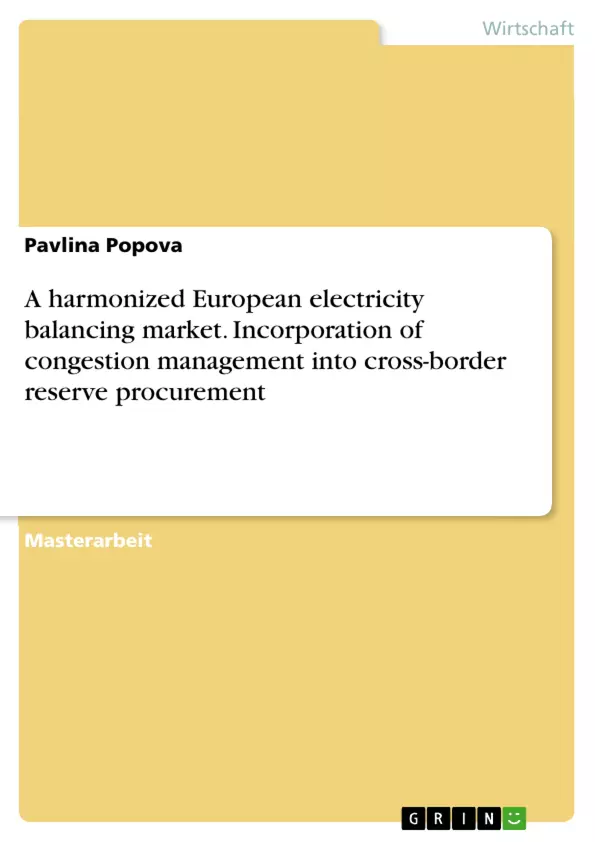The thesis is structured as follows. Section 2 gives an overview of the current electricity market design and Section 3 integrates the balancing market in the framework and presents the economical and technical conditions, including the relevant design variables. Section 4 describes the benefits from cross-border coordination in reserve markets and introduces possible integration models. Within Section 5, model requirements are formulated and one suitable model is selected. Section 6 presents the selected methodology and Section 7 gives the obtained case study. Section 8 evaluates the model and discusses the proposed expansion involving the flow-based approach. Lastly, Section 9 concludes and gives further research prospects.
European electricity markets have changed profoundly in the last decades. In national markets increased deregulation and privatization have accompanied the decoupling of transmission, distribution and generation activities. Simultaneously, markets in Europe are becoming more interconnected and harmonized. Until now, the focus was primarily set on the harmonization and integration of spot and forward markets. Nonetheless, the short-term regulation of flexible short-term operating reserves within the balancing market is gaining attention in academia and industry, especially due to the increased penetration of intermitted renewables, which leads to more short-term deviation in the power grid and hence to operational uncertainty.
Corresponding to the zonal nature of the European power market, today’s operating reserve markets are mainly organized on a national level. Within a European cross-border balancing market, however, Transmission System Operators could coordinate their balancing activities with other control areas. Such cross-border balancing markets increase social welfare and operational reliability, since the amount of reserves required could be decreased through spatial smoothing of imbalances and the costs of reserve procurement and activation can be reduced.
Nevertheless, cross-border reserve markets are constrained by the available cross-border transmission capacity. Therefore, a challenging issue is to account properly for network constraints, especially within the procurement of reserves, which happens before real-time and under uncertainty as neither the remaining cross-border capacity nor the activation status of the procured reserves is known.
Inhaltsverzeichnis
- Introduction
- Current electricity market design in Europe
- Forward and future market
- Day-ahead market
- Intra-day market
- Balancing market
- Operating reserve market design in continental Europe
- Power-frequency control by the TSO
- Operating reserve types and technical conditions
- Economic conditions
- Operating reserve planning
- Cross-border coordination in reserve markets
- Benefits of cross-border reserve markets
- Principal options for reserve market coordination
- Current practice in Europe
- Cross-border capacity reservation
- Design framework for the incorporation of network constraints in cross-border balancing markets
- Design space determination
- Operating reserve type
- Operating reserve scheduling
- Integration model and cross-border transmission capacity reservation approach
- Model selection
- Design space determination
- Methodology
- Model assumptions
- Model structure
- Theoretical model formulation
- Stage 1: day-ahead energy market
- Stage 2: day-ahead reserve procurement
- Stage 3: real-time reserve activation
- Model calibration
- Case study and data validation
- Results
- Generation cost and system reliability
- Generation and reserve scheduling
- Generation utilization of transmission capacity
- Critical examination and continuation
- Model evaluation
- Model extension proposition
- Available Transfer Capacity
- Flow-Based Market Coupling implementation
- FBMC parameters
- Expected outcome and conceivable challenges
Zielsetzung und Themenschwerpunkte
Diese Masterarbeit untersucht die Integration des Netzmanagements in die grenzüberschreitende Reservebeschaffung im europäischen Strommarkt. Das Ziel ist es, einen harmonisierten europäischen Strommarkt zu entwickeln, der die Effizienz steigert und die Zuverlässigkeit des Stromsystems verbessert.
- Analyse der aktuellen Strommarktstruktur in Europa
- Bewertung der bestehenden Verfahren zur grenzüberschreitenden Koordinierung von Reserven
- Entwicklung eines Rahmenwerks für die Einbeziehung von Netzbeschränkungen in die grenzüberschreitende Strommarktregelung
- Anwendung eines Simulationsmodells zur Evaluierung der Auswirkungen des vorgeschlagenen Rahmenwerks
- Diskussion der Herausforderungen und Potenziale der Implementierung eines harmonisierten europäischen Strommarktes
Zusammenfassung der Kapitel
- Kapitel 1: Einführung
Dieses Kapitel liefert eine Einleitung in das Thema der Arbeit und erläutert die Relevanz des Themas im Kontext der europäischen Energiepolitik. Es werden die Herausforderungen im europäischen Strommarkt und die Bedeutung einer harmonisierten Marktregelung dargestellt. - Kapitel 2: Aktuelle Strommarktstruktur in Europa
Dieses Kapitel gibt einen Überblick über die aktuelle Strommarktstruktur in Europa und beleuchtet die verschiedenen Marktstufen, von der Vorwärts- und Terminmarkt bis hin zum Intraday- und Ausgleichsmarkt. - Kapitel 3: Design des Betriebsreservenmarktes im kontinentalen Europa
Dieses Kapitel beschreibt die Funktionsweise des Betriebsreservenmarktes im kontinentalen Europa, einschließlich der technischen und wirtschaftlichen Bedingungen für die Bereitstellung von Betriebsreserven. - Kapitel 4: Grenzüberschreitende Koordinierung in Reservenmärkten
Dieses Kapitel analysiert die Vorteile grenzüberschreitender Reservenmärkte und untersucht verschiedene Koordinationsmechanismen, die zurzeit in Europa angewandt werden. - Kapitel 5: Design-Rahmenwerk für die Integration von Netzbeschränkungen in grenzüberschreitenden Ausgleichsmärkten
Dieses Kapitel entwickelt einen Rahmen für die Integration von Netzbeschränkungen in die grenzüberschreitende Strommarktregelung. Es werden verschiedene Design-Optionen für den Betriebsreserve-Typ, die Betriebsreserve-Planung und die Integration in das Marktmodell diskutiert. - Kapitel 6: Methodik
Dieses Kapitel beschreibt die Methodik der Arbeit, einschließlich der Modellannahmen, der Modellstruktur und der theoretischen Modellformulierung. Es wird ein dreistufiges Modell vorgestellt, das den Tages-Ahead-Energiemarkt, die Tages-Ahead-Reservebeschaffung und die Echtzeit-Reservenaktivierung abbildet. - Kapitel 7: Modellkalibrierung
Dieses Kapitel beschreibt die Kalibrierung des entwickelten Modells anhand einer Fallstudie und validiert die Ergebnisse anhand von Daten aus dem europäischen Strommarkt.
Schlüsselwörter
Die Arbeit konzentriert sich auf die Themen des europäischen Strommarkts, der grenzüberschreitenden Reservebeschaffung, des Netzmanagements, der Integration von Netzbeschränkungen und der Entwicklung eines harmonisierten europäischen Strommarktes. Schlüsselbegriffe sind: Netz- und Betriebsreservemanagement, grenzüberschreitende Koordination, Marktkopplung, Strommarktmodellierung, Simulationen und Netzbeschränkungen.
- Quote paper
- Pavlina Popova (Author), 2017, A harmonized European electricity balancing market. Incorporation of congestion management into cross-border reserve procurement, Munich, GRIN Verlag, https://www.grin.com/document/368020



